
The so-called denture butterfly is a partial removable immediate-denture. In turn, this means the following important design nuances:
- Partial means that the prosthesis is used to replace small defects in the dentition (most often when one or two teeth are lost);
- Removable means that the patient can easily remove the structure from the oral cavity (for example, to care for it);
- Immediate - that is, used immediately (lat. "Immediatus" means "direct"). In most cases, butterfly prostheses are used to replace the extracted teeth directly on the day of surgery.
Now let's see why, in fact, this removable denture is called a “butterfly”.
Everything is very simple. The most popular type of the prosthesis under consideration has a visual resemblance to a butterfly: the fastening elements of the structure (plastic clasps), like insect wings, cover adjacent teeth.
The photos below show classic examples of prosthetic butterflies:
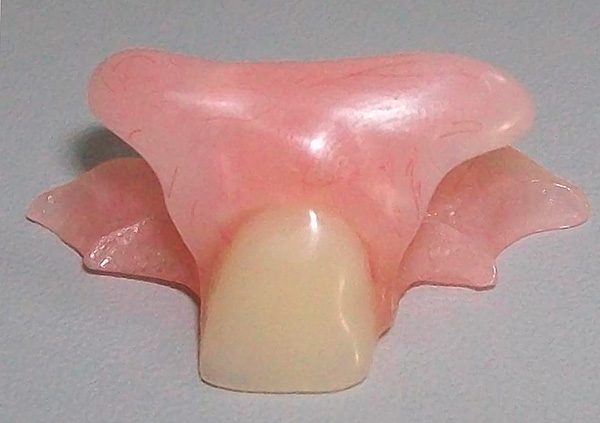
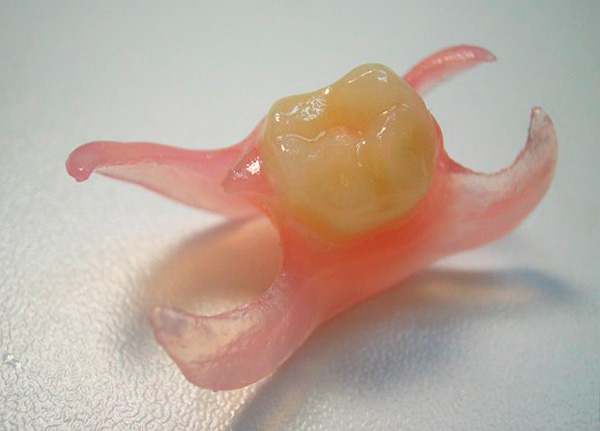
It is interesting
It should be noted that not always artificial butterflies are similar to these butterflies. Anyway, the name is trivial (not nomenklatura), so the line between the “butterfly” and, say, “caterpillar” is very conditional.
For example, if a large number of teeth are removed, then the immediate prosthesis may look like this:
You must admit that it is no longer very similar to a butterfly.
Is it possible to use a prosthetic butterfly for permanent prosthetics without resorting to dental implantation or the installation of a bridge?
This question becomes quite relevant for the patient when it turns out that the price for the manufacture of a butterfly prosthesis is on average about 10 times lower than the cost of installing a quality dental implant. Well, then we consider in detail the service life of the structure, its advantages, as well as the disadvantages that prevent the use of a temporary prosthesis as a permanent one.
For those who do not want to go "without teeth" for several weeks
An unexpected loss of any tooth (especially in the smile area) can cause a strong emotional reaction, even panic and prolonged stress.This is especially true of the loss of front teeth in those patients who are obliged to communicate with people every day — journalists, actors, teachers, doctors, etc. In some cases, it can even be a temporary cessation of professional activity with a concomitant decrease in a person’s financial income.
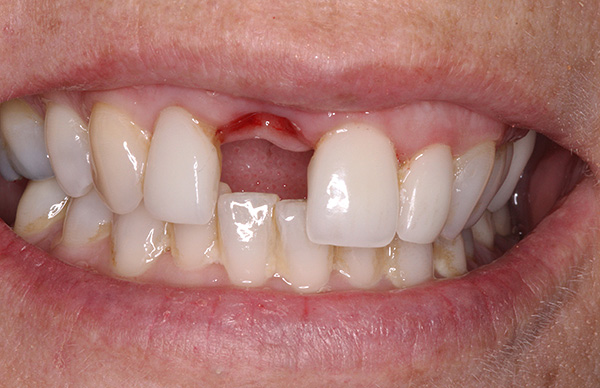
In such cases, prostheses-butterflies come to the rescue.
As an example, consider the classic situation that orthopedic dentists face quite often: the patient turns to a “prosthetist” doctor complaining about the unsatisfactory condition of one or several teeth, and often come with already existing holes in the dentition. The situations can be different: significant destruction of the crown part of the teeth, their mobility, impaired function of chewing and aesthetics due to a missing tooth, etc.
In many cases, problem teeth and their remnants (roots) are to be removed, followed by prosthetics. And here the patient has a logical question: how much time will you have to walk with the “hole” in the dentition until the prosthesis is ready?
On a note
In budgetary clinics, the situation in this regard is, as a rule, far from rosy: it can be a couple of weeks, or several months. It is clear that not everyone is willing to endure in anticipation of the restoration of a normal smile for so long, even for the sake of money (especially if we take into account that sometimes such savings go sideways for health - more on that below).
That is why for those people who do not want to walk without teeth for several weeks, the method of immediate-prosthetics was invented. Modern dentures butterflies (and other immediate versions of the prostheses) allow, at the removal of 1, 2 and even more teeth, to immediately replace them with an aesthetic prosthesis.
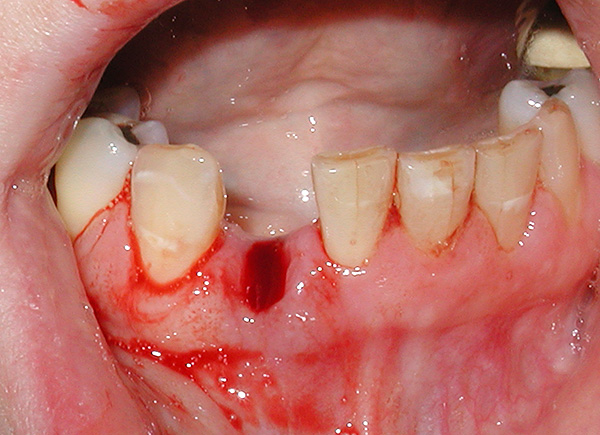
Today, dentists, who are not indifferent to the physical and mental state of the patient, work according to the principle: “came with teeth — went along with them,” and for this there are various options for intermediate prostheses in general and prosthetic butterflies in particular.
The device of artificial limbs and their varieties
As already noted above, the removable prosthesis-butterfly received its name due to the external similarity with the butterfly - a characteristic feature of the design is the presence of plastic hooks (clasps), with the help of which the prosthesis is held on the supporting teeth.As you understand, the abutment teeth must be in good condition in order to be able to take on the additional load.
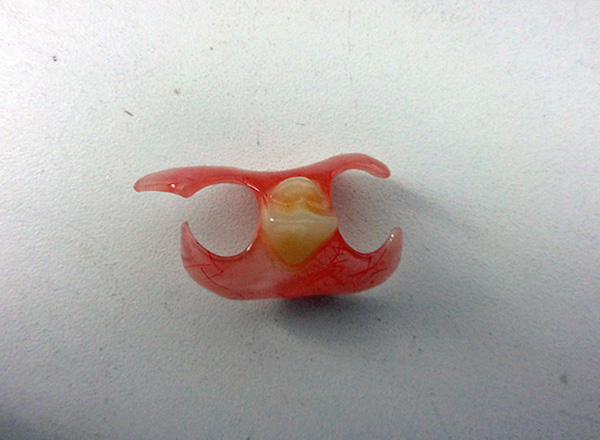
On a note
An important advantage of prostheses-butterflies is the absence of the need to prepare abutment teeth for crowns, that is, they do not need to be ground with a drill.
The basis of the prosthesis is a plastic base, which usually holds 1-2 teeth. By the way, the teeth are also made of plastic.
Plastic for the manufacture of base and hooks has a pink color - the color of the gums. Depending on what kind of plastic is used, butterfly prostheses are divided into:
- Acrylic;
- Nylon (for example, the so-called Quadrotti prostheses).
Nylon prostheses are positioned as more modern and comfortable: soft elastic nylon irritates mucous membranes less and causes allergic reactions less often (but at the price nylon butterfly prostheses will be more expensive). The acrylic construction is rigid, more often leads to discomfort and more often causes allergic reactions.
Photo of a nylon butterfly prosthesis:
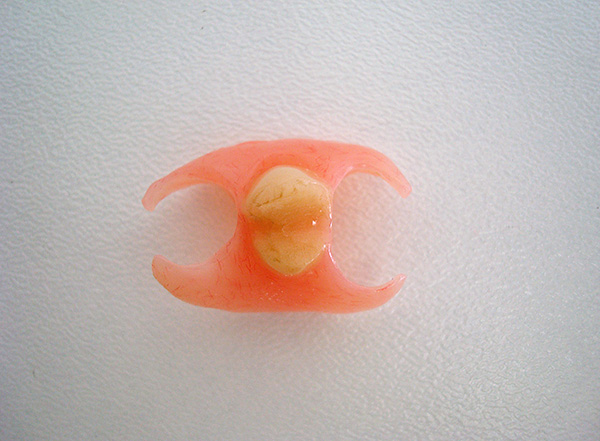
On a note
Quadrotti nylon butterfly prostheses (Quattro Ti) are lighter than similar standard acrylic plastic constructions.In addition, due to the elasticity of nylon, the prosthesis does not break when it falls (as practice shows, older people often drop dentures, breaking them, and repair can often cost several thousand rubles).
The number of teeth fixed in the prosthesis may be different: more often it is 1-2 teeth, but there may be more. At the same time, it is difficult to call the prosthesis “butterfly”:
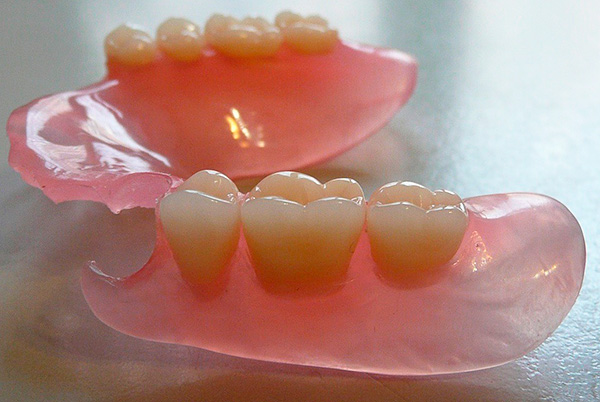
In fact, with an increase in the number of prosthetic teeth, the prosthesis-butterfly “transforms” into a so-called clasp prosthesis on clams (“bugel” means “arc”):

Feedback
“Recently, I suffered a small stroke, so they refused to put the implant right away, and recommended to walk with a temporary prosthesis with a butterfly for a couple of months. Made instead of the front tooth. The first week was difficult to bite off anything, but then I got used to it, it became quite bearable. Plastic hooks allow you to take it off and put it on when you need it. I must say that he requires care no less than his teeth, even more. But it looks like a native tooth, and many cannot even find it right away ... "
Oleg, 55 years old, Moscow
Is it possible to do without temporary prosthetics?
Despite,that the prosthesis-butterfly allows you to minimize the aesthetic and functional defects that appear after tooth extraction, the most economical patients often try, so to speak, to evade temporary prosthetics, considering it to be a banal money-out.
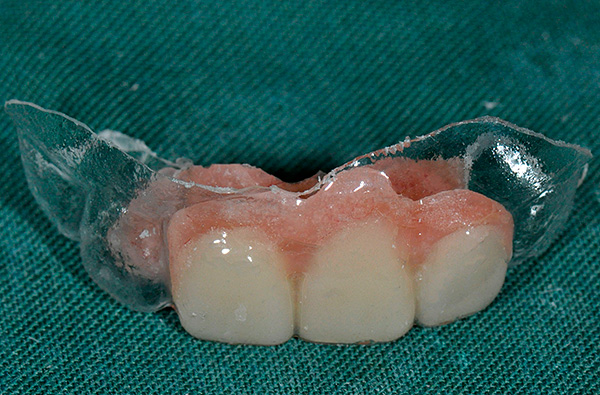
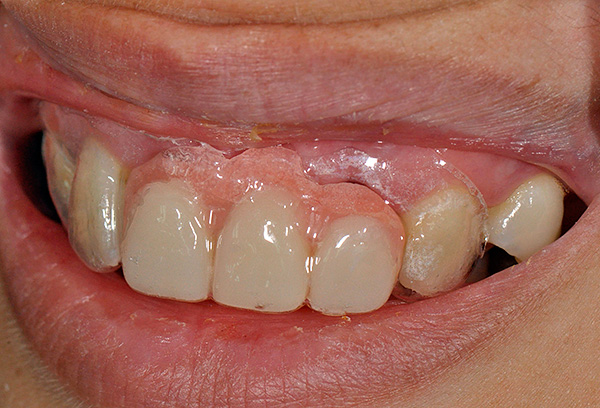
However, it should be borne in mind that the immediate dentures provide not only the restoration of the aesthetics of the dentition and the usual way of life, but also help to protect adjacent teeth from displacement. And even these very important moments are only a part of those “utilities” that present temporary hollow butterfly prostheses to their owners.
Let's see what happens in practice after removing even 1 tooth - this will allow a better understanding of the importance of temporary prosthetics.
Here is a simple example: the patient realized the need to remove the roots of the teeth, the edges of which regularly injured the buccal mucosa. After removing the annoying 3 teeth, he, of course, felt the need to “prosthetic” - well, somewhere in a year or two, since then, perhaps, the situation with finances will become more comfortable.
And everything would be fine, but after half a year our hero noticed that his teeth began to lean in the direction of the gaping voids of the dentition. Moreover, on the opposite jaw, the teeth opposite the voids began to move out significantly from the hole (as if to grow).
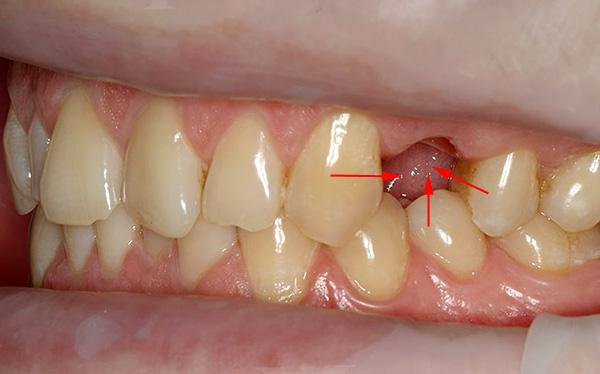
After another couple of months, the patient loses the filling, although nothing seemed to foretell such a disaster. Appeals to the dentist therapist. When the doctor asks if the patient will “insert” the teeth, our hero answers that he will definitely do it some day. As a result, the dentist-therapist, seeing the absence of teeth and in the expectation that dentures will appear in their place, makes the filling lower in height than it should be.
After another couple of weeks, another filling falls out, which is in the zone of active bite, and then - according to the classical scenario: as a result of overloading, the strongly inclined teeth adjacent to the defect become mobile (in other words, start to lurch).
What is the biggest mistake here? The patient made the right decision to replace his lost teeth with a prosthesis. The problem is that the planned treatment was, to put it mildly, strongly delayed, and this had time to lead to quite natural undesirable consequences.Although this could have been easily avoided, if we smoothly move to the goal according to the treatment plan outlined by the orthopedic surgeon, which may include, for example, the temporary use of the same artificial limbs.
In such a case as dental prosthetics, selectively ignoring individual recommendations of the orthopedic dentist often leads to poor results. Temporary prosthetics with an immediate prosthesis gives time for comfortable healing of the holes after removal of the teeth (while the prosthetic bed is being prepared) and provides prevention of undesirable alteration of the bite due to the displacement of the teeth.

It is interesting
The classical method of dental implantation involves deferred prosthetics: first, the gums should heal and bone tissue will form after tooth extraction. Then it usually takes several more months for the osteointegration of the implant to complete, that is, for the implant to merge with the bone. And the prosthetic butterfly in this case would have been most welcome, allowing the patient to smile normally, chew food and not be afraid about the displacement of the teeth.
The possibilities of dentures butterflies, and from what problems they will save you
That is, as you already understood, it is very undesirable to do for a long time without prosthetics of missing teeth, as this promises problems - and the further, the problems are more pronounced.
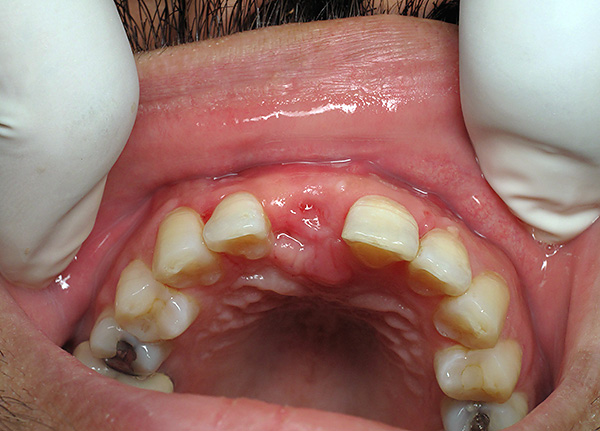
So let's summarize the issues that can be avoided with the help of removable denture butterflies. Distribute them in order of occurrence in the practice of the dentist:
- Offset teeth in the direction of the defect. The tilt angle depends on individual features. The displacement of the teeth is stretched in time, and progresses more rapidly with a large number of extracted teeth, an abnormal bite and chewing of food initially on one side;
- Antagonist-tooth extension (on the opposite jaw) in the direction of the defect. The tooth, having lost its antagonist, begins to shift towards the healing gums. Some patients note that the tooth seems to have “grown.” And indeed, it is being pushed out of the hole, since it does not receive a sufficient chewing load. The use of a butterfly prosthesis allows you to maintain a normal chewing load on the antagonist tooth;
- Overloading the remaining teeth and their increased abrasion.The absence of some teeth causes the re-formation of the so-called functioning groups of teeth in the mouth, which take the brunt of chewing food. A “blow” can be considered both in the direct and in the figurative sense - from knocking out fillings and ending with the abrasion of the enamel of the mounds of the chewing teeth and the cutting edges of the frontal group;
- Overloading of the temporomandibular joint (temporomandibular joint). Since after removal of the teeth from the bite-holding group, there is a reorganization of the whole dental-maxillary system, this is often reflected in the function of TMJ. Its deformity is not immediately noticeable, but then there may be a crunch, a click, difficulty opening the mouth, pain, a constant feeling of discomfort, etc. A denture butterfly, despite being removable and not necessarily permanently worn, effectively prevents these undesirable effects;
- Impaired chewing muscles and reduced chewing effectiveness. If it is simpler to say - pieces of food fly in the stomach intact. That is, without dental prosthetics, the patient risks earning problems with the gastrointestinal tract (which, generally speaking, is a very frequent consequence of chewing disorders due to the long absence of teeth).
As you can see, in functional terms, even the most inexpensive prosthetic butterfly could save you from many potential problems in the period from tooth extraction to permanent prosthetics.
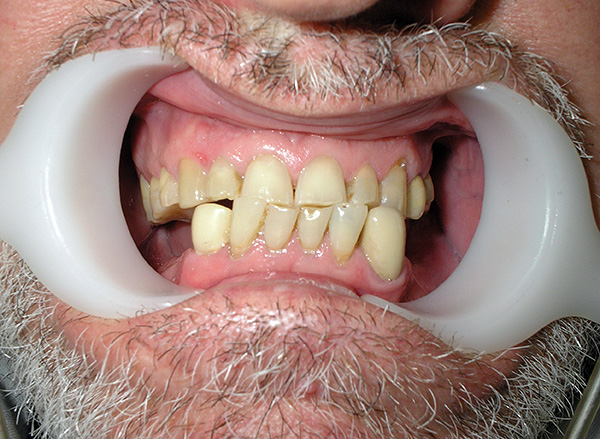
Question: Should I remove the prosthesis for the night?
With regular care of the prosthesis with a toothbrush and toothpaste (and with the condition of normal healing of the hole in the place of the extracted tooth), there is no need to remove the prosthesis for a long time, you can wear it almost all the time.
We can not say about the problems of a psychological nature, when the front teeth are lost, for example, due to mechanical injury. It is often not possible to carry out permanent prosthetics for a couple of days, and meanwhile, a person needs to make up for a cosmetic defect as soon as possible. Failure to do this quickly can be fraught with a variety of negative consequences: from panic and stress to suicidal feelings.
Temporary prosthetics using a quickly manufactured denture butterfly for a patient can be a real life-buoy in the seemingly hopeless situation itself.Actually, this is the essence of the immediate prosthetics (aesthetics and chewing function are restored immediately). With the right approach, the prosthesis will be almost imperceptible and indistinguishable from natural teeth.
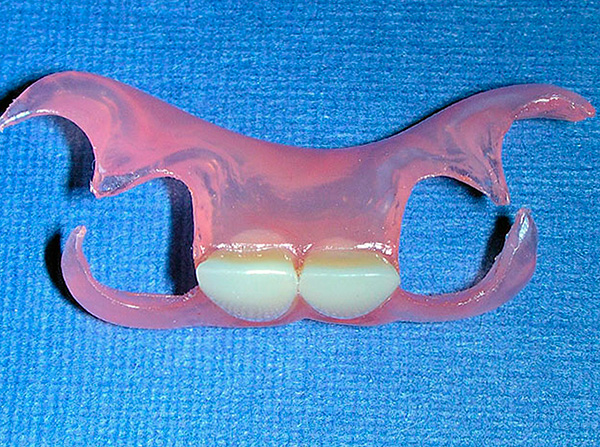
The photo below shows the state of the dentition before and after prosthetics using the immediat butterfly butterfly:
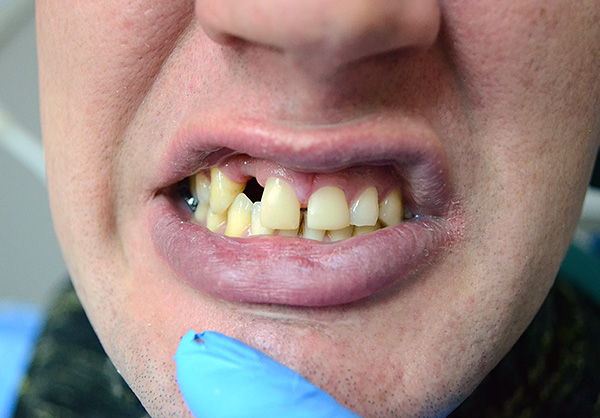
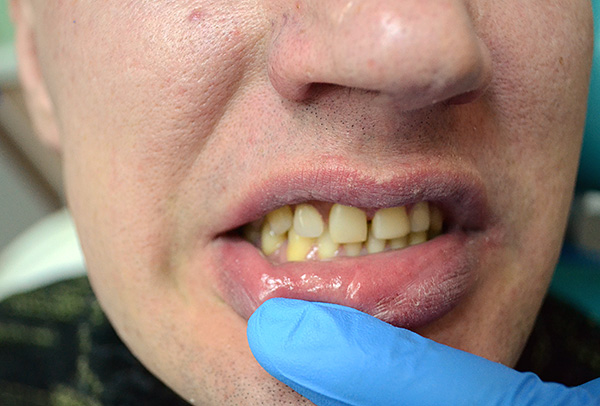
It is interesting
Since the immediate prosthesis itself is immediate, that is, carried out immediately after the removal of the tooth or its residues, in this context the butterfly prosthesis also performs a protective function, protecting the blood clot from external influences (for example, from damage by food pieces). Thus, a temporary prosthesis helps to accelerate the regeneration of the tissues of the hole and helps reduce the risk of developing alveolitis - inflammation of the hole.
Some design flaws and ways to overcome them
If we analyze patient reviews about the prosthesis of a bow tie, then we can make the following list of the most frequently noted design flaws:
- Short life The fact is that the design of a temporary prosthesis does not initially imply its use for several years.A denture butterfly is designed for a period of use of about 2-3 months, after which, ideally, permanent prosthetics should be made (however, as they say, there is nothing more permanent than temporary - some patients have been using the denture for several years);
- Insufficiently strong attachment of the prosthesis (flies when chewing). It should be noted here that, in the overwhelming majority of cases, a well-made prosthesis-butterfly rests on the supporting teeth very reliably, and if you don’t chew nuts and chew toffee, then “pulling” it off the supporting teeth when chewing is very problematic. If the prosthesis is made with inaccuracies and stays fragile - this is a surmountable situation, and the correction of the prosthesis in a dental clinic most often solves this problem;
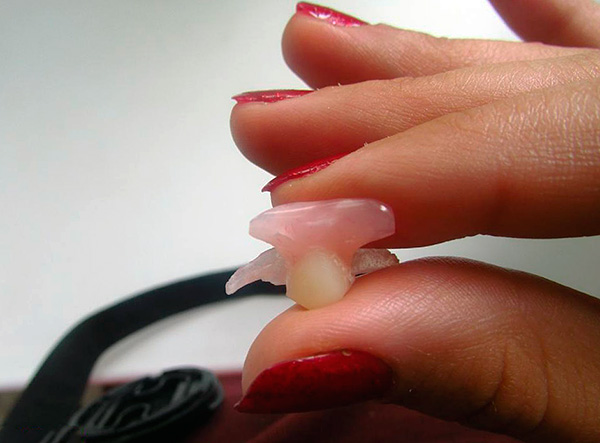
- The fragility of the prosthesis. This applies primarily to prosthetic-butterflies made of acrylic plastic (nylon are elastic). More often break hooks clums. Well, in the presence of a denture it is really important to control the diet, avoid hard foods and eliminate bad habits (biting threads, nails, husk seeds, etc.). And also should try not to drop the prosthesis.
On a note
In order to extend the service life of a removable immediate denture and avoid problems during the temporary prosthetics stage, it is important to ensure competent maintenance of the structure. For example, a prosthetic butterfly should be regularly removed after eating, washed and cleaned from food debris. This is done using a conventional toothbrush and paste.
If there is a desire to remove the prosthesis for a long time, then it is desirable to store it in a special liquid for the storage of dentures.
- Lack of aesthetics (the tooth is not similar to its own, or the basis and the denture clasps are too noticeable with a smile). The leading role here is played by how well a prosthetic butterfly was made and what materials were used. Expensive and high-quality materials in combination with the skill of the doctor almost always work wonders, and a temporary prosthesis can be difficult to distinguish from natural teeth. Of course, the price in this case will be higher. Below are the before and after pictures and prosthetics using a butterfly prosthesis:

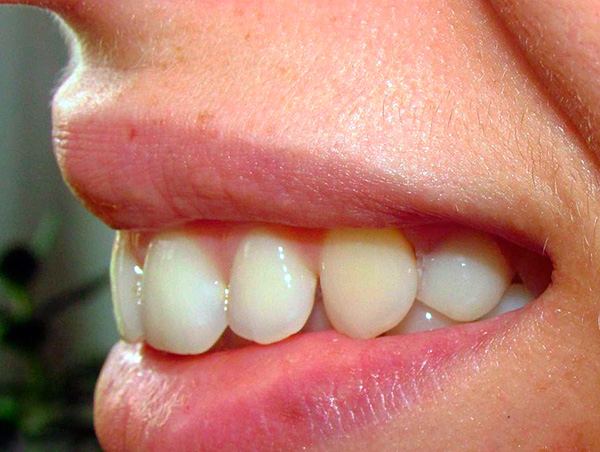

- Inconvenience when wearing. Sometimes there are problems with diction and constant discomfort in the mouth. These problems are quite common, and each patient is expressed individually - from mild to very severe.
Feedback:
“Because of periodontal disease, I had to gradually remove all the teeth in the lower jaw. For some time I went with a partial prosthesis, a butterfly. Made of acrylic. It was hell, I could not get used to it. Then the second portion of teeth was removed, she put in a nylon prosthesis, she spent 1.5 years with him. Now it was the turn to remove the remaining teeth. I feel disabled ... "
Elena, Moscow
And one more review:
“If a gag reflex occurs and initially keeps on being disgusting, then go for a rework. This means that the prosthesis is poorly fitted, the problem will not disappear, and then it will only get worse. I went through this with my first prosthetic butterfly, there was a constant gag reflex, and initially it was champing. It was impossible to walk with him ... "
Oksana, Yekaterinburg
Speaking about the shortcomings of prosthetic-butterflies, it is necessary to note one important point, to which a large number of patients do not pay special attention at all. The idea is that a denture butterfly is, above all, a temporary prosthesis that is not capable of fully replacing a lost tooth.
The prosthetic butterfly, in contrast to the implant, does not fully ensure the transfer of the chewing load to the jaw bone tissue in the region of the extracted tooth, as a result of which the bone will gradually atrophy here. That is, if you decide to wear a temporary denture as a permanent one, you will have to regularly adjust it, since the prosthetic bed (gum) will gradually subside.
With a large number of teeth removed, gradual atrophy of the jaw bone tissue leads to a characteristic (senile) change in facial features.
Stages of manufacturing a denture butterfly
Two specialists take part in creating the prosthesis: an orthopedic dentist and a dental technician. As already noted above, acrylic plastic (including Acry-Free acrylic resins, which rarely cause allergies), as well as nylon (including Dental-D nylon plastic), can be used as basic materials.
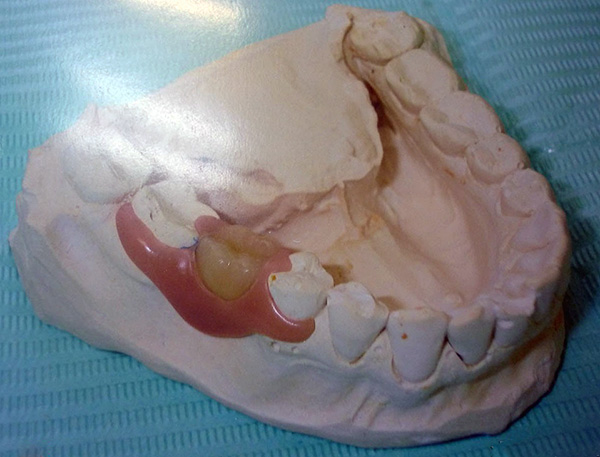
The fabrication of a butterfly prosthesis takes place in several stages. Here is a brief sample diagram:
- Examination of the oral cavity. At this stage, the orthopedic surgeon together with the patient draw up a plan for the forthcoming treatment. Including agree on the features of the immediate-prosthetics - from the material and shape of the structure to the terms of wearing and the frequency of correction of the prosthesis;
- Removal of the impression (impression), which allows to obtain a negative image from the jaws. This stage is performed before the extraction of the teeth - in this case, the accuracy of the work will be higher, rather than when the impression is taken with already missing teeth (then you have to take a picture and use it to model the missing teeth when making the prosthesis);
- Making a dental technician in the laboratory prosthesis of acrylic or nylon;
- Trying the finished design in the patient's oral cavity (after removal of the problematic teeth) and the correction of the prosthesis, if necessary.
How much now "butterflies": approximate prices
Of course, the final price of the prosthesis-butterfly (and in general, any dental service) is influenced by the status of the clinic, and the skill level of the specialist, and sometimes the region of residence. Therefore, further we will talk about prices on average in the market.
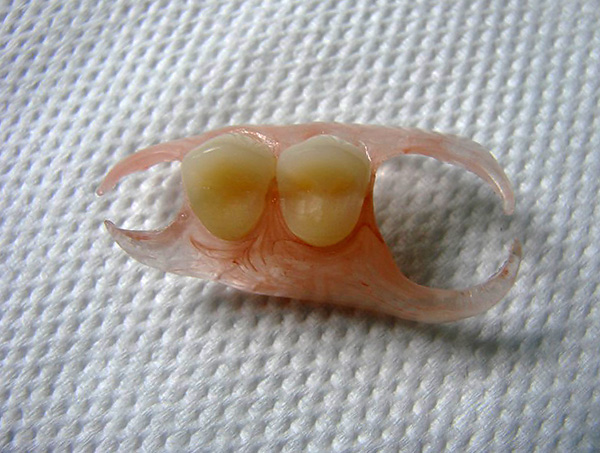
In addition, when estimating the financial costs of prosthetics, it is also necessary to consider the number of prosthetic teeth (1, 2, 3 or more), since each missing tooth contributes to the cost of materials and work. That is, the price of one tooth will be a kind of starting point.
On a note
A significant role in the final cost of the work is played by the material of construction. Butterfly prostheses from ordinary acrylic plastic are the cheapest, and more expensive are nylon. The difference in price fully reflects the difference in the aesthetic-functional properties of the immediate dentures. That is, the “cooler” it looks and is more convenient to use, the less money will remain in the wallet.
In Moscow, the price of a butterfly prosthesis for one tooth can vary from 15 to 40 thousand rubles, and in regions - from 5 to 25 thousand.
If you have personal experience using a denture butterfly, be sure to share it by leaving your review at the bottom of this page (in the comments box).
Useful video about the pros and cons of removable nylon dentures
How reliable are dentures and what kinds of them are


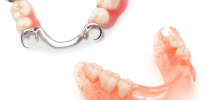
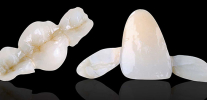
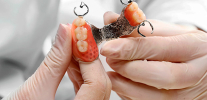
I have been carrying a butterfly instead of a missing tooth in my upper jaw for 5 years. When I eat, rented. I work as a teacher, and no one realizes that there is no tooth! I recommend everyone to remove enamel and put a bridge or an implant! Now I want to put on the missing root!
And really get used to the butterfly? Put today, it is unusual, I want to take off! I feel it all the time!
An important role is played by the place of the implant installation. In the upper jaw, perhaps, really get used to, but at the bottom - is problematic. I've been feeling it all the time now for 1 month. I have a nylon butterfly, large in size, on the lower chewing tooth. When I do not chew, everything is fine, I just feel a little something foreign in my mouth.But when I chew, it is very unpleasant.
How much did the tooth cost you?
I go with a plate of 10 years. Everything is fine)
I wear a “butterfly” 5 years! On the lower jaw, 3 teeth. Satisfied with everything. One is bad - some dark speck appeared inside.
I put the butterfly on the top five a week ago. I do not feel any discomfort, although there is a feeling that a caramel in the mouth (or gum) has stuck to the gum. Sometimes I hear a disturbance in the pronunciation of hissing sounds. The main inconvenience - already flew 2 times during meals (food is normal, not nuts or toffee). When flies, there is a risk to see through it, or even worse - to choke them.
Another unpleasant caveat - the tooth has an inferior size. That is, outside it corresponds in size, but in width 2 times already removed. Thus, the load when chewing on the gums and on the paired tooth in the lower jaw is uneven. The doctor said that the tooth is not made in size, but only clasps. I do not know, believe it or not. I would like to clarify, is this true? Correct exactly needed, otherwise it will fall out.
Hello Tatiana.A “butterfly” is a temporary construction, that is, a prosthesis that replaces only an aesthetic defect. For full chewing, it is not intended at all. Therefore, the size of the chewing surface is minimal. Usually such a prosthesis is derived from the bite, that is, it does not participate in chewing food. But to improve the fixation of such a prosthesis can and should be. Refer to your orthopedic surgeon and tell about the inconvenience - you can correct the disadvantages of the prosthesis.
Good day! All conveniences and inconveniences depend on the dental technician and on how correctly the impression was taken. The first prosthesis that I was given a week ago was very hard on me (a nylon butterfly prosthesis, a tooth 6). Grind, cut, it became convenient. But it turned out that a lot was removed - the prosthesis began to fly. Departing with him a week, got used to. Made a new, comfortable. Yesterday, when dressed, I wanted to take off. They put in the evening, the doctor asked for a little inconvenience. In the morning I woke up - and almost forgot that there is a prosthesis. When chewing a little bit of pressure and the tongue I feel the plate, but comfortable. I hope that I will wear for a long time) The doctor dissuaded the implant.